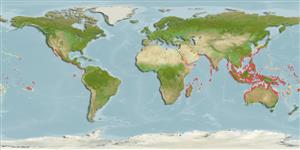Common names from other countries
>
Anguilliformes (Eels and morays) >
Ophichthidae (Snake eels) > Ophichthinae
Etymology: Pisodonophis: Greek, piso, pipisko = to drink + Greek, odous = teeth + Greek, ophis = serpent .
More on author: Richardson.
Environment: milieu / climate zone / depth range / distribution range
Ecologia
marinhas; Água doce; estuarina associadas(os) a recifes; anádromo (Ref. 51243); intervalo de profundidade 1 - 20 m (Ref. 90102). Tropical
Indo-Pacific: Red Sea and East Africa to French Polynesia, north to the Ogasawara Islands, south to Australia.
Tamanho / Peso / Idade
Maturity: Lm ? range ? - ? cm
Max length : 108 cm TL macho/indeterminado; (Ref. 1479); common length : 50.0 cm TL macho/indeterminado; (Ref. 7245)
Descrição breve
Chaves de identificação | Morfologia | Morfometria
Espinhos dorsais (total) : 0; Espinhos anais: 0; Vértebras: 152 - 163. Teeth molariform, multiserial on jaws, intermaxillary and vomer; dorsal fin with broad dark edge (Ref. 37816). Dorsal fin beginning above pectoral fin (Ref. 12693). Body snake-like, cylindrical, compressed only along extreme tail tip; anterior nostril tubular, posterior nostril along lower edge of lip; median fins not continuous posteriorly; extreme tip of tail stiff and finless; dorsal fin origin over front to middle portion of pectoral fins; lateral line inconspicuous (Ref. 4832). Variable from grey to black or brown. Large individuals have wrinkled skin (Ref. 48635).
Occurs in lagoons and estuaries, entering freshwater (Ref. 12693). Often in tidal channels where loose groups congregate, and usually seen with just the head exposed (Ref. 48635). Caught most often in tidal areas and estuaries (Ref. 12693). Caught in bag nets and similar gear. Marketed fresh (Ref. 7050).
Life cycle and mating behavior
Maturities | Reprodução | Spawnings | Egg(s) | Fecundities | Larvas
McCosker, J.E. and P.H.J. Castle, 1986. Ophichthidae. p. 176-186. In M.M. Smith and P.C. Heemstra (eds.) Smiths' sea fishes. Springer-Verlag, Berlin. (Ref. 3972)
Categoria na Lista Vermelha da IUCN (Ref. 130435)
CITES (Ref. 128078)
Not Evaluated
Ameaça para o homem
Harmless
Utilização humana
Pescarias: pouco comercial
Ferramentas
Relatórios especiais
Descarregue XML
Fontes da internet
Estimates based on models
Preferred temperature (Ref.
115969): 24.2 - 29.3, mean 28.4 (based on 3721 cells).
Phylogenetic diversity index (Ref.
82804): PD
50 = 0.5020 [Uniqueness, from 0.5 = low to 2.0 = high].
Bayesian length-weight: a=0.00063 (0.00032 - 0.00123), b=3.01 (2.84 - 3.18), in cm Total Length, based on LWR estimates for this species & (Sub)family-body (Ref.
93245).
Nível Trófico (Ref.
69278): 3.8 ±0.6 se; based on size and trophs of closest relatives
Resiliência (Ref.
120179): Médio, tempo mínimo de duplicação da população 1,4 - 4,4 anos (Preliminary K or Fecundity.).
Fishing Vulnerability (Ref.
59153): High vulnerability (65 of 100).
